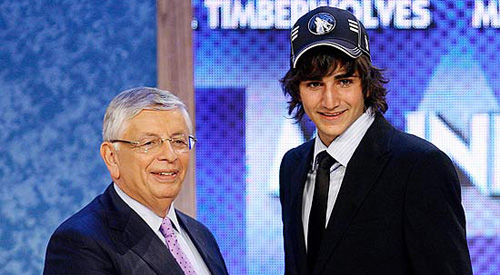
What Ricky Rubio’s arrival means to Minnesota
It’s been two seasons now since the Minnesota Timberwolves drafted Ricky Rubio, three since he burst onto the NBA stage in the 2008 Olympic Gold Medal game where his Spanish club was the first to really challenge the fabled U.S. Redeem Team.
It’s been a few weeks since the Timberwolves’ 2010-11 season ended, where they finished in the NBA’s cellar with 15 wins and where, at the shank end of the season, they were giving tickets away for free.
But it’s only been a few days since Rubio’s season ended, with him scoring zero points in Barcelona’s final game. In the entire best-of-three series, he only scored three points.
Now, the question of if he’ll ever cross over to the NBA is fast becoming a question of when he’ll suit up.
The way Rubio has played in Europe does not inspire confidence. He has a hard time getting off the bench and when he does, he’s barely effective: the three points in the championship series, for instance.
But the promise of what he can bring is what keeps him on the radar. The potential for explosive talent, the ball-handling ability like Pete Maravich, the thought of him and fellow Timberwolf Kevin Love running pick-and-rolls all night are tantalizing. For a team at the league’s bottom, he’s an attractive promise.
There’s already a young core at Minnesota’s heart. There’s Love, he of the 30-30 game and a ridiculous 20-rebound streak. There’s Anthony Randolph and Michael Beasley. They’re a team that can grow. That will grow. And they’ll be powered by Rubio.
[php snippet=1]
“They’re starting to actually round out the cornerstones of the franchise,” says Zach Harper of the TrueHoop network Minnesota Timberwolves blog A Wolf Among Wolves. “Love is their best player right now, Beasley is an adequate (yet inefficient) scoring wing right now and Rubio could be the straw that stirs the drink.”
Note that such a core does not include Jonny Flynn. This past season, Flynn’s numbers regressed, his PER fell from 13.0 to 7.1, his shooting numbers and scoring dropped and he finished the year with a negative Win Share. These stats aren’t really a sign that Flynn was a bust. After all, he was dogged by a nagging hip injury, but they could suggest a case of Hello Rubio, Goodbye Flynn.
There are already rumors about the Wolves shopping him, most notably to the Knicks for Toney Douglas (who, it should be noted, put up better numbers in more minutes last season than Flynn), and Rubio hasn’t even played a game yet.
“He was probably really expendable before, but now there is simply no reason to pretend he’s a part of the rebuilding plan like they did two years ago when they picked him right after Rubio,” says Harper.
With Rubio, though, the Wolves can’t be sure what they’re getting. Since 2008, his play has been erratic, downward even. For instance, his stats this season on Barcelona aren’t impressive: 6.5 points, 3.6 assists in about 23 minutes per game.
But how much of that is from his play versus how he’s used?
NBA Playbook has a great scouting report on Rubio that explains the dichotomy in his numbers. In a nutshell, the difference between how he looked last season and how he was back in 2008 is how he was used: he’s gone from a team where he was a playmaker to one where he played away from the ball. The whole piece is worth a read, especially for it’s detailed looks at his shooting and defense. The picture it paints is more positive than most stories circulating about Rubio usually tell.
Another question about Rubio is exactly how he’d fit into Minnesota’s offense. This past season, they ran a triangle-based offense. But that system doesn’t fit with Rubio’s (or Flynn’s, for that matter) skill set. Rubio’s strengths lay in making passes and creating plays, not in floating around. After all, he’s a strong passer, not a strong scorer.
But there’s so much to like about Rubio, from his passing to his defense to his attitude. He’s somebody who, shortly after an introductory press conference, took to the gym to shoot jumpers. A Stephon Marbury he is not.
With a recent history that could be charitably described as mixed, it feels odd to call the Timberwolves a team that demands to be seen. But, suddenly, that’s what happened. Love was already a standout player, but he wasn’t appointment viewing. In fact, given the attendance problems the team’s had, he wasn’t even close, though through no fault of his own.
“This team has been very depressing for years now, and now they have something to bring energy back into the Target Center,” says Harper. “In a couple of seasons, if they can draft somewhat intelligently (unfathomable, I know) and keep developing their young guys, they could be a decently dangerous playoff team around 2014.”
With Rubio at the reigns, the entire outlook of the franchise has changed, his impact transcends the court. A player of his remarkably rare skill set is thrilling to watch, which means more fun for the casual fans who don’t appreciate Love’s ability to grab a dozen rebounds as they should. Now all of a sudden, regardless of when the Wolves finally start to cash in on their obvious potential, the franchise is once again must-see-TV.
The wait was worth it.
[php snippet=1]

